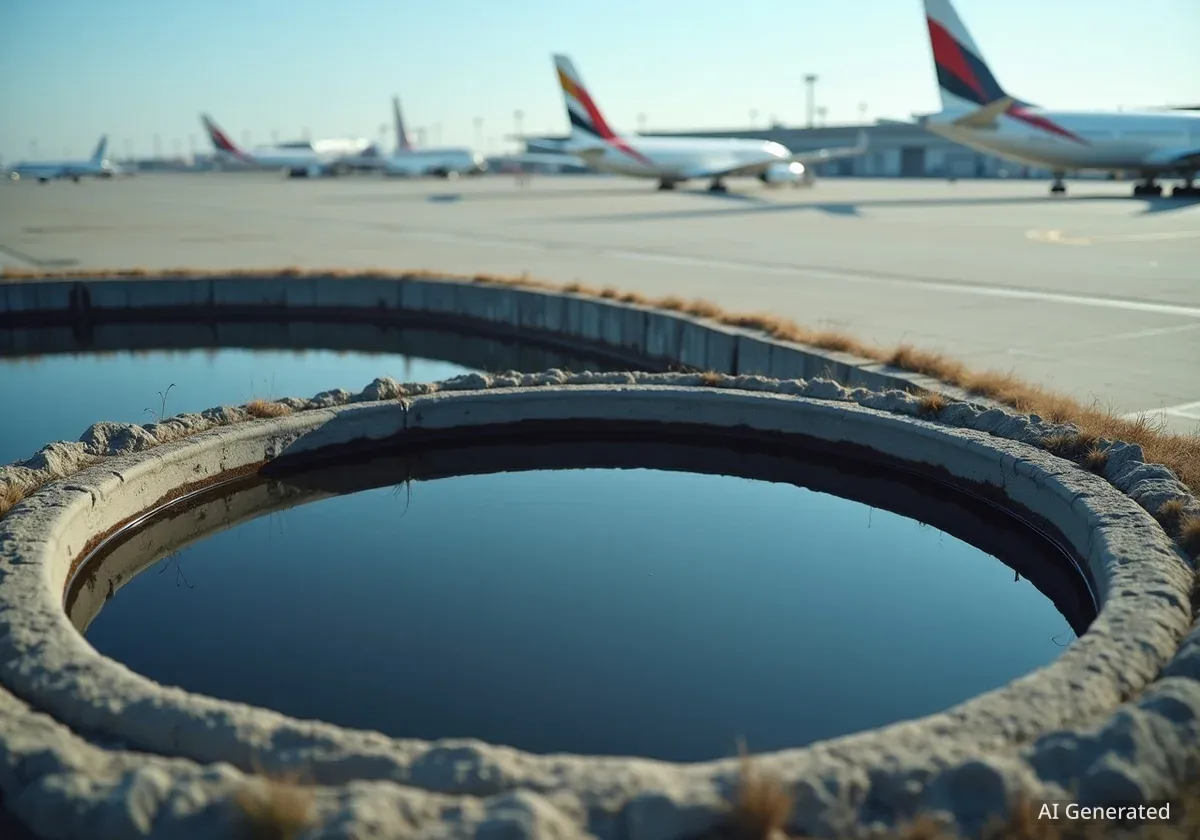A significant jet fuel overflow occurred at Las Vegas Airport early Saturday morning, but authorities quickly contained the incident. Fire officials confirmed no injuries were reported, and airport operations, including flights, remained unaffected.
Key Takeaways
- Jet fuel overflow happened just after 7 a.m. Saturday.
- Between 30 and 100 gallons initially reported, 5,000 gallons contained.
- Incident contained within a designated retention basin.
- No injuries to civilians or emergency responders.
- Airport flights and operations were not disrupted.
- Cause of the overflow is currently under investigation.
Emergency Response and Containment Efforts
The incident began just after 7 a.m. on Saturday. Emergency dispatchers received a call reporting a jet fuel overflow at the Las Vegas Airport. Initial reports suggested a spill of approximately 30 to 100 gallons.
Upon arrival, first responders found jet fuel actively overflowing from an above-ground tank. Fortunately, the spill was contained within a designated retention basin surrounding the tank. This critical infrastructure prevented the fuel from spreading further into the environment.
“Accountability of all employees took place; exposure lines were pulled as a precaution but were not needed,” fire officials stated, emphasizing the safety measures taken.
The rapid response by airport and fire personnel was crucial. They quickly assessed the situation and confirmed that the containment system was working as intended. This immediate action helped to mitigate potential risks and ensure public safety.
Quick Facts
- Time of Incident: Shortly after 7 a.m. Saturday
- Initial Report: 30-100 gallons of fuel
- Total Contained: 5,000 gallons
- Location: Above-ground fuel tank, retention basin
No Impact on Flights or Safety
Despite the large volume of fuel involved, the incident had no impact on airport operations. Flights continued as scheduled, and there were no reported delays or cancellations. This outcome highlights the effectiveness of the airport's emergency protocols and containment infrastructure.
Safety was a primary concern for the responders. Fire officials confirmed that no injuries were sustained by civilians or the firefighters involved in the containment efforts. This is a testament to the training and equipment available to handle such emergencies.
The incident occurred in a controlled area of the airport, specifically designed to handle potential fuel spills. This design includes features like retention basins, which are essential for environmental protection and operational safety in aviation facilities.
Airport Fuel Systems
Modern airports utilize complex fuel storage and distribution systems. These systems are designed with multiple layers of safety, including secondary containment measures like retention basins. These basins are built to hold large volumes of liquid in case of a tank failure or overflow, preventing environmental contamination and ensuring operational continuity.
Investigation Underway
The cause of the jet fuel overflow remains under investigation. Authorities will examine the fuel tank, its components, and the operational procedures to determine why the overflow occurred. Understanding the root cause is essential to prevent similar incidents in the future.
Investigations into airport incidents often involve multiple agencies, including fire departments, airport operations, and potentially environmental protection agencies. These teams work together to gather data, analyze evidence, and identify contributing factors.
Preventative measures and regular maintenance are critical for airport infrastructure, especially for fuel storage. Ensuring the integrity of tanks, pipes, and safety systems is a continuous process to maintain high safety standards.
Importance of Aviation Safety Protocols
Aviation safety protocols are among the most stringent in any industry. Incidents like a fuel overflow, while contained, underscore the importance of these protocols. They involve not only technical systems but also rigorous training for personnel and clear emergency response plans.
The ability to quickly contain a spill of 5,000 gallons of jet fuel without any disruption to flights or injuries is a significant positive outcome. It demonstrates the robustness of the airport's emergency preparedness. The investigation's findings will likely lead to further enhancements in safety procedures.
Airport authorities are committed to maintaining a safe environment for both passengers and staff. Lessons learned from this incident will contribute to ongoing efforts to improve operational safety and environmental protection at the facility.
Safety Statistics
- No injuries reported (0 civilians, 0 firefighters)
- 0 flight disruptions
- 100% containment within basin
Future Steps and Continued Monitoring
Once the investigation concludes, any necessary corrective actions will be implemented. This could involve repairs to equipment, updates to operational procedures, or additional staff training. The goal is always to enhance safety and prevent recurrence.
Airport facilities are under constant scrutiny to ensure compliance with federal and international safety standards. Regular inspections and audits are part of this process, providing continuous oversight of critical infrastructure.
The Las Vegas Airport continues to operate normally. Further updates on the investigation's findings will be released as they become available. The focus remains on ensuring the highest level of safety and operational efficiency.





